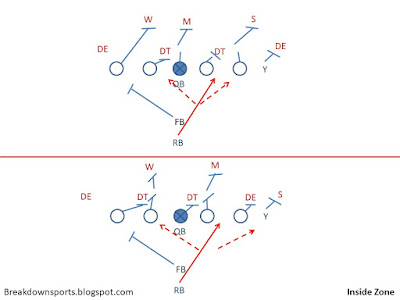Title : History and Evolution: Power O - Bonus - "Power" within the Zone Architecture
Review : History and Evolution: Power O - Bonus - "Power" within the Zone Architecture
History and Evolution: Power O - Bonus - "Power" within the Zone Architecture
It always bugged me when at Michigan, Rich Rod would call his Lead Outside Zone play "Power". Football terminology is notoriously inconsistent from program-to-program, where the same word can mean very different things. But Power had established a sort of agreement and consistency, it is down blocks on the frontside with a backside puller, a true gap/man scheme. Yet here was Rich Rod calling Outside Zone "Power." It made my head hurt for a long time, until one day I was looking through the Joe Gibbs's playbook, and the rationale behind it struck me.
As I noted in the History and Evolution Series, power itself was originally focused on the Power Sweep, as a sort of variant to the inside run and option series. As Option Teams (often Wing T types) moved more toward zone blocking in the 70s, Power had to be adapted in ways to fit what they did. Rarely did these teams pull within the formation, it was mostly zone blocking, occasional traps as a change up, and maybe a lead pull around the edge.
So thinking within the sense of not pulling blockers (even around the edge), you ask how you can still get outside the formation. The answer becomes outside zone blocking with a lead back trying to open up the alley. And you get this, from Joe Gibbs's playbook (which also contained traditional Power O by then).
"Power" for lead Outside Zone is a Joe Gibbs holdover. Here he has drawn up "Power" and "Power O" pic.twitter.com/Ul0JhBHCQn
— Space Coyote (@SpaceCoyoteBDS) August 13, 2020
Now, the idea behind it and how it converges with more traditional power isn't too difficult to understand. When you think of traditional Power, you think of a kickout block, a puller from the backside, and frontside combo blocks to the backside of the play.
The easiest way to picture this Gibbs's "Power" is to think of Inside Zone first, specifically, Lead Inside Zone. On Lead Inside Zone, your FB is responsible for the front side LB, the same player the backside puller targets in traditional Power O. As your FB is responsible for the front side LB, the zone combos, which are typically vertical in nature, now work back one person at the 2nd level. In other words, the frontside combos now work back at the second level.
So your traditional zone looks like this (here with a split block from the FB):
And becomes something more like this:
And what it effectively looks like is single back Power O, where the FB replaces the backside puller.
Now remember, for the zone teams, what they were really working into their playbook was the Power Sweep, but it's not all together different in concept, except the blocking up front is Outside Zone blocking. This essentially means instead of the combos working further playside, they'll be more vertical in Lead Outside Zone, but the idea is the same, the aiming point is one player back as the FB accounts for the playside LB as a lead blocker (taking the role that the backside Guard traditionally plays as a lead blocker in Power O).
And that is how Rich Rod and Joe Gibbs came about "Power" as an outside zone play and it looked like this (here with a fake split flow in the backfield).
And that's how this becomes "Power" (with a fake split flow from the RB) pic.twitter.com/0k5oAPkz3U
— Space Coyote (@SpaceCoyoteBDS) August 13, 2020
Here it is with multiple backs near the goal line
And protected by an early version of a same side pop pass in the slot (note: the outside WR runs a hitch route that is used if playside DBs are dropping off to handle the inside verticals)
Note: Both retained traditional Power O within their offenses, but at least in the case of Rich Rod, was not favored compared to zone blocking.
History and Evolution - Power
Part I - The Power Series Origins
Part II - Off Tackle Power Earns the Name Power
Part III - The Modern Era of Power Diversity





0 Response to "History and Evolution: Power O - Bonus - "Power" within the Zone Architecture"
Post a Comment